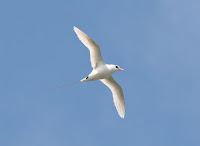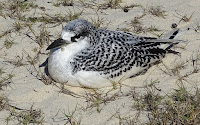RED-TAILED TROPICBIRD
RED-TAILED TROPICBIRD (Phaethon rubricauda) – (See images below)
DESCRIPTION: The Red-tailed Tropicbird is a white pelagic seabird. The slightly downcurved bill is red, and there is a black ‘comma’ around the eye. The legs and feet are black. The red fine tail (streamers) is twice as long as the body. Sexes are similar. The bird is around three feet long (one meter), including the tail.
VOICE: https://www.xeno-canto.org/species/Phaethon-rubricauda
NAME: The English name refers to the range of this bird and to its tail color. The Latin genus name ‘Phaethon’ is from Greek and means ‘sun’, while ‘rubricauda’ means ‘red tail’.
HABITAT: Small oceanic islands in tropical seas. Has been observed further out at sea than other tropicbird species.
DIET: Flying fish and squid. Red-tailed tropicbirds can dive from the air at heights up to 150 feet (45 meters). It swallows its prey before leaving the water, thus making it more difficult for frigatebirds to steal its catch.
NESTING: This species breeds in loose colonies on small islands. The nest is a scrape on a rock outcrop, in a crevice, under a shrub or on a sandy beach. One single beige egg with brown blotches is laid. Both parents incubate the egg and feed the chick. The chicks are white and the juveniles have a mottled black and white plumage.
DISTRIBUTION: The Red-tailed tropicbird range covers the tropical Pacific and Indian oceans. It breeds as far south as New Zealand (see reference below). Indigenous to Hawaii, where it is found on Kauai and Oahu (where it breeds on small windward islands such as Manana-Rabbit). However it is more common on the Northwestern Hawaiian Islands.
CONSERVATION: Although listed as ‘least concern’, feral predators (rats, mongoose) eat the eggs and chicks of this bird where they are present. The red feathers of the tail were harvested in the past. Yellow crazy ants are also a threat in some parts of Australia.
NOTES: As with many other seabirds that fly effortlessly, red-tailed tropicbirds walk with difficulty on the ground due to their short legs and their location toward the back of the body.
SIMILAR SPECIES: White-tailed Tropicbird, Red-billed Tropicbird
REFERENCES: https://en.wikipedia.org/wiki/Red-tailed_tropicbird
https://www.arkive.org/red-tailed-tropicbird/phaethon-rubricauda/
https://identify.whatbird.com/obj/529/overview/Red-tailed_Tropicbird.aspx
http://www.nzbirdsonline.org.nz/species/red-tailed-tropicbird
DESCRIPTION: The Red-tailed Tropicbird is a white pelagic seabird. The slightly downcurved bill is red, and there is a black ‘comma’ around the eye. The legs and feet are black. The red fine tail (streamers) is twice as long as the body. Sexes are similar. The bird is around three feet long (one meter), including the tail.
VOICE: https://www.xeno-canto.org/species/Phaethon-rubricauda
NAME: The English name refers to the range of this bird and to its tail color. The Latin genus name ‘Phaethon’ is from Greek and means ‘sun’, while ‘rubricauda’ means ‘red tail’.
HABITAT: Small oceanic islands in tropical seas. Has been observed further out at sea than other tropicbird species.
DIET: Flying fish and squid. Red-tailed tropicbirds can dive from the air at heights up to 150 feet (45 meters). It swallows its prey before leaving the water, thus making it more difficult for frigatebirds to steal its catch.
NESTING: This species breeds in loose colonies on small islands. The nest is a scrape on a rock outcrop, in a crevice, under a shrub or on a sandy beach. One single beige egg with brown blotches is laid. Both parents incubate the egg and feed the chick. The chicks are white and the juveniles have a mottled black and white plumage.
DISTRIBUTION: The Red-tailed tropicbird range covers the tropical Pacific and Indian oceans. It breeds as far south as New Zealand (see reference below). Indigenous to Hawaii, where it is found on Kauai and Oahu (where it breeds on small windward islands such as Manana-Rabbit). However it is more common on the Northwestern Hawaiian Islands.
CONSERVATION: Although listed as ‘least concern’, feral predators (rats, mongoose) eat the eggs and chicks of this bird where they are present. The red feathers of the tail were harvested in the past. Yellow crazy ants are also a threat in some parts of Australia.
NOTES: As with many other seabirds that fly effortlessly, red-tailed tropicbirds walk with difficulty on the ground due to their short legs and their location toward the back of the body.
SIMILAR SPECIES: White-tailed Tropicbird, Red-billed Tropicbird
REFERENCES: https://en.wikipedia.org/wiki/Red-tailed_tropicbird
https://www.arkive.org/red-tailed-tropicbird/phaethon-rubricauda/
https://identify.whatbird.com/obj/529/overview/Red-tailed_Tropicbird.aspx
http://www.nzbirdsonline.org.nz/species/red-tailed-tropicbird
 |
| Red-tailed tropicbird, HI, Dick Daniels |
 |
| Red-tailed tropicbird, HI, Alan Schmierer |
 |
| Red-tailed tropicbird on nest with chick by Gerald Ludwig, USFWS |
 |
| Young red-tailed tropicbird, John Surrey |